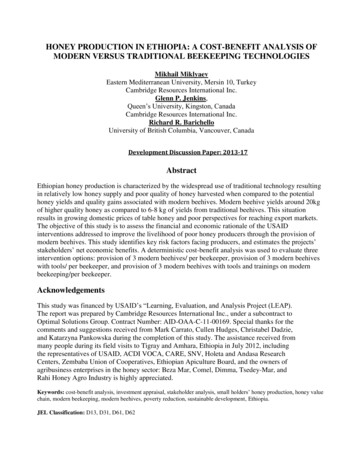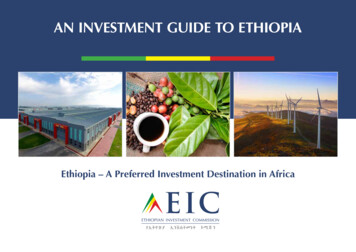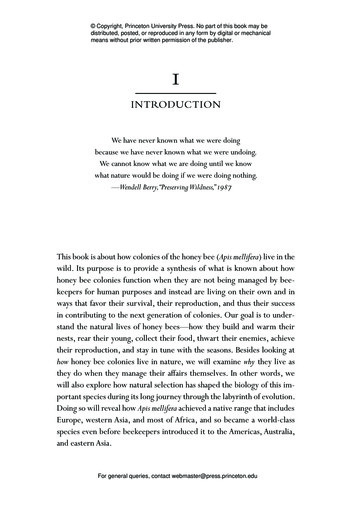
Transcription
HONEY PRODUCTION IN ETHIOPIA: A COST-BENEFIT ANALYSIS OFMODERN VERSUS TRADITIONAL BEEKEEPING TECHNOLOGIESMikhail MiklyaevEastern Mediterranean University, Mersin 10, TurkeyCambridge Resources International Inc.Glenn P. Jenkins,Queen’s University, Kingston, CanadaCambridge Resources International Inc.Richard R. BarichelloUniversity of British Columbia, Vancouver, CanadaDevelopment Discussion Paper: 2013-17AbstractEthiopian honey production is characterized by the widespread use of traditional technology resultingin relatively low honey supply and poor quality of honey harvested when compared to the potentialhoney yields and quality gains associated with modern beehives. Modern beehive yields around 20kgof higher quality honey as compared to 6-8 kg of yields from traditional beehives. This situationresults in growing domestic prices of table honey and poor perspectives for reaching export markets.The objective of this study is to assess the financial and economic rationale of the USAIDinterventions addressed to improve the livelihood of poor honey producers through the provision ofmodern beehives. This study identifies key risk factors facing producers, and estimates the projects’stakeholders’ net economic benefits. A deterministic cost-benefit analysis was used to evaluate threeintervention options: provision of 3 modern beehives/ per beekeeper, provision of 3 modern beehiveswith tools/ per beekeeper, and provision of 3 modern beehives with tools and trainings on modernbeekeeping/per beekeeper.AcknowledgementsThis study was financed by USAID’s ―Learning, Evaluation, and Analysis Project (LEAP).The report was prepared by Cambridge Resources International Inc., under a subcontract toOptimal Solutions Group. Contract Number: AID-OAA-C-11-00169. Special thanks for thecomments and suggestions received from Mark Carrato, Cullen Hudges, Christabel Dadzie,and Katarzyna Pankowska during the completion of this study. The assistance received frommany people during its field visits to Tigray and Amhara, Ethiopia in July 2012, includingthe representatives of USAID, ACDI VOCA, CARE, SNV, Holeta and Andasa ResearchCenters, Zembaba Union of Cooperatives, Ethiopian Apiculture Board, and the owners ofagribusiness enterprises in the honey sector: Beza Mar, Comel, Dimma, Tsedey-Mar, andRahi Honey Agro Industry is highly appreciated.Keywords: cost-benefit analysis, investment appraisal, stakeholder analysis, small holders’ honey production, honey valuechain, modern beekeeping, modern beehives, poverty reduction, sustainable development, Ethiopia.JEL Classification: D13, D31, D61, D62
ACRONYMSACDI-VOCANongovernmental Organization, Implementing OrganizationADSCRAnnual Debt Service Coverage RatioAGPAgriculture Growth Program (Program)AMDeAgribusiness and Market Development (Program)CBACost-Benefit AnalysisCFConversion FactorCSACentral Statistical Agency of EthiopiaEBAEthiopian Beekeepers AssociationEHBPEAAssociationEthiopian Honey and Beeswax Producers and ExportersEOCKEconomic Opportunity Cost of CapitalETBEthiopian Birr (Currency)FAOFood and Agriculture OrganizationFEPForeign Exchange PremiumFtFFeed the Future (Program)GDPGross Domestic ProductIRRInternal Rate of ReturnHaHectarekgKilogramMoAEthiopian Ministry of AgricultureMTMetric TonsNGONongovernmental OrganizationNPVNet Present ValueSNVNetherlands Development AgencyUS United States Dollar2
EXECUTIVE SUMMARYProject Description: The Agricultural Growth Program-Agribusiness And Market Development (AGP-AMDE)for Ethiopia belongs to the comprehensive Feed the Future (FtF) strategy developed by the USAID for the foodinsecure developing countries. The main goals of the AGP-AMDE include the reduction of poverty and hungerby improving productivity and competitiveness of value chains that would give rural households greateropportunities for increases in employment and income. The USAID/Mission Ethiopia will begin theimplementation of the AGP-AMDE project in 2012, in 83 woredas around Ethiopia. Within the duration of thisproject the USAID plans to specifically target six commodity value chains: maize, wheat, coffee, sesame,chickpeas and honey.The total budget provided for improvements in the Ethiopia’s honey value chain is 248,000.00 ETB and thecommodity specific objectives in the AGP-AMDE include increase in quantity of honey supplied to the marketthat is combined with achieving higher quality of table honey (USAID, AGP-AMDE, 2012). The benefits fromsuch increase in quality and quantity of honey supplied to the market are twofold. First of all Ethiopia will beable to meet domestic supply requirements associated with its strong within the country demand for honey.Secondary, the country will be able to additionally expand its potential opportunities for honey exports.Strategic Context and Rationale: The USAID Ethiopia has included honey in its AGP- AMDE project inorder to address supply problems related to the current status quo in the Ethiopian honey sector. Most of honeyproduced within the country (95.57% of total honey production) comes from traditional beehives that generallydeliver low yields (5-7kg/beehive) and low quality of honey. Modern honey production that includes the use ofmodern style beehives is still in Ethiopia at a very low level. Out of 4,993,815 beehives present in Ethiopia inyear 2011, only 139,682 were modern beehives (CSA, Agricultural Survey, 2012). This widespread use oftraditional technology in honey production results in relatively low honey supply and poor quality of honeyharvested when compared to the potential honey yields and quality gains associated with modern beehives.Modern beehive yields around 20kg of higher quality honey. This situation results in growing domestic prices oftable honey and poor perspectives for reaching export markets. The proposed in this evaluation interventions inhoney value chain include: Intervention A: provision of 3 modern beehives/ per beekeeper, Intervention B:provision of 3 modern beehives with tools/ per beekeeper, Intervention C: provision of a ―package solution‖, 3modern beehives plus tools plus trainings on modern beekeeping/per beekeeper. These interventions wereevaluated in two distinctive regions of Ethiopia, Amhara and Tigray.Financial and Economic Analysis Results: The basic assumption of this analysis is that each beekeeper intargeted household in both analyzed regions will receive 3 modern beehives. In intervention A these are just 3modern beehives (boxes), in Intervention B these are 3 modern beehives (boxes) plus tools necessary toproperly manage the beehives and under Intervention C these are 3 beehives with necessary tools and trainingon modern beekeeping. The average cost of capital is assumed to be at the level of 12%. In order to obtainfinancing required to upgrade the current honey production into modern style apiary, the beekeepers would needto provide a down payment at the level of 28% of the total loan. In addition in order to avoid negative cashflows in the first year of the project, additional loan at market based interest rate of 48% would need to beintroduced. These two loans will assure successful introduction of proposed interventions. Upon appraisalpursued on each of the proposed interventions following results were obtained:1. The financial NPV from the viewpoint of the Equity/Beekeeper, ―incremental‖ (in real terms):For Amhara: Intervention A: USD 314Intervention B: USD 571Intervention C: USD 1082.For Tigray:Intervention A: USD 1780Intervention B: USD 2922Intervention C: USD 4866.2. The economic NPV obtained in the analysis:For Amhara, Intervention A: USD 422Intervention B: USD 704For Tigray,Intervention A: USD 2059Intervention B: USD 3305Intervention C: USD 1200.Intervention C: USD 5320.3
The levels of economic IRR:For Amhara, Intervention A: 48%,For Tigray,Intervention A: 137%,Intervention B: 47%Intervention B: USD 153%Intervention C: 76%.Intervention C: 342%Beneficiary Analysis Results: The main beneficiaries of proposed Interventions A, B and C are government ofEthiopia, beekeepers and those that will engage themselves into provision of inputs necessary to managemodern beehives (labour). The division of economic benefits among stakeholders is presented below:AmharaIntervention A: Government: USD 82.42Intervention B: Government: USD 128.46Intervention C: Government: USD 204.55Beekeepers/Labour:USD 53.41Beekeepers/Labour: USD 56.98Beekeepers/Labour: USD 53.68TigrayIntervention A: Government: USD 238.61Intervention B: Government: USD 362.75Intervention C: Government: USD 551.63Beekeepers/Labour: USD 83.57Beekeepers/Labour: USD 87.85Beekeepers/Labour: USD 52.58Conclusions and Recommendations: The high economic NPV observed in case of both regions as well as highlevels of the economic IRR show that the economic benefits to Ethiopia of each of the proposed Interventions A,B and C, in both analyzed regions, Amhara and Tigray are expected to outweigh the costs. At the expected foreach region honey price and yields the Equity/Beekeeper’s financial NPV will be the highest in case ofIntervention C. The highest economic NPV is also in case of Intervention C. Therefore Intervention C isrecommended as the best option for improvements in Ethiopia’s honey value chain. From the results obtained inthis CBA it is clear that USAID’s financing provided for AGP-AMDE project will have positive impact onhoney sector in Ethiopia.4
METHODOLOGYIntroduction and Project BackgroundEthiopia is recognized as one of the poorest and most food-insecure countries in the world. It is primarily a netexporter of agricultural products, with 85 percent of its population employed in agriculture. Ethiopianagriculture contributes more than 45 percent to the nation’s gross domestic product (GDP) and significantlyaffects the country’s export trade (USAID, AGP-AMDe, 2012).It has been widely acknowledged that the Ethiopian agricultural sector has the potential to drive the country’seconomic development, which could translate into a reduction in poverty and could increase the food security ofits people.In recognition of the unexploited potential that exists in the Ethiopian agricultural sector, the United StatesAgency for International Development (USAID) has decided to include value chains of several commodities inits leading Agricultural Growth Program-Agribusiness and Market Development (AGP-AMDe). The AGPAMDe project belongs to the comprehensive Feed the Future (FtF) Strategy for Ethiopia, whose main goalsinclude reducing poverty and hunger by improving the productivity and competitiveness of value chains thatwould give rural households greater opportunities for increasing their employment and income. The mainconstituents of AGP-AMDe revolve around four components:1.2.3.4.improving the competitiveness of selected value chains;improving access to finance;improving the enabling environment of selected value chains; andimproving innovation and investment.The AGP-AMDe project specifically targets six value chains—maize, wheat, sesame, coffee, honey, andchickpeas—and aims to reduce poverty and food insecurity in 83 woredas around the country.Commodity-specific objectives in the honey value chain in the AGP-AMDe project include increasing thequantity (supply) and quality of honey to meet strong domestic and export demand for table honey (USAID2012).Honey production and beekeeping are environmentally friendly practices and relatively easy to engage in. Thesenonfarming business activities have the potential to provide a wide range of economic contributions. Two maineconomic values could be derived from engaging in beekeeping: income generation from marketing honey andits by-products (beeswax, royal jelly, pollen, propolis, bee colonies, and bee venom) and the creation of nongender-biased employment opportunities.Additional benefits from beekeeping are associated with the purely biological nature of bees’ activities, such asplant pollination and conservation of natural flora. Because of its relatively low labor requirements, whenproperly handled, beekeeping can coexist almost effortlessly with regular farming activities, such as growingcrops, horticulture production, and animal husbandry.Commodity BackgroundEthiopia is one of the top 10 producers of honey in the world, and it is the largest one in Africa (USAID, AGPAMD, 2012). The total volume of honey production in 2011 was estimated to be 39.89 million kilograms (kg)(CSA 2012a). The country’s potential for honey production, the variety of natural honey flavors associated withthe country’s diverse sources of bee forage, and Ethiopian honey’s desirable qualities, such as low moisturecontent, have been widely recognized. Beekeeping and honey production in Ethiopia form an ancient tradition5
that has been incorporated into Ethiopian culture and even the country’s religious customs. Ethiopia is also thecountry with the longest history of marketing honey and beeswax in Africa. Ethiopians use honey in place ofsugar to sweeten their foods and to boost their caloric intake. The average household in Ethiopia is composed ofsix people, and annual honey consumption is estimated to be 10 kg per household. Honey in Ethiopia isgenerally produced as a cash crop, with yearly sales amounting to 90 to 95 percent of total production.Currently, the majority of honey produced (about 70 percent of the 90 to 95 percent designated for sale) is soldto tej houses. The remaining portion is marketed as table honey for general consumption (Tadesse and Phillips2007).Production Regions and VolumesHoney is produced in almost all parts of Ethiopia, with distinctive types of honey coming from different regions.Probably the most famous and characteristic in terms of color and taste comes from Tigray. The honey’s purewhite color (due to bees foraging on Tebeb plant [Basium clandiforbium]) and its low moisture content havegarnered fame; some people even believe that this honey has medicinelike proprieties. Even though such claimsrelated to the healing capabilities of Tigray’s honey have not been proven scientifically, they are well groundedin local people’s minds and widely accepted as fact. Similar in terms of color, white honey is produced in theHighlands of southwest and southeast Ethiopia, but it does not have the same prestige and renown as Tigray’shoney.Yellow honey, also referred to as multi-flora honey, is also commonly produced and available in almost allregions of Ethiopia. It is harvested in many different parts of the country and gets its color from the variouscrops produced.The third type of honey is referred to as Lalibela honey and is produced in central Ethiopia. Its maincharacteristics include light color and fine creaminess that come from bees foraging on acacia trees. Thisparticular honey variety is well known and in high demand in the domestic market.Somewhat less-appreciated varieties of Ethiopian honey are dark brown in color and bitter in taste, making themless popular for consumption. They are produced in areas with altitudes of 1,200 to 2,400 meters (m) above sealevel.The last type of honey widely produced and marketed is crude red honey. Its main usefulness and popularityamong beekeepers comes from its low quality requirements, because tej houses buy it in crude, totallyunprocessed form to produce an Ethiopian type of mead (Agonafir 2005).Ethiopian honey differs not only in color, taste, and quality but also in the quantity produced and the timing ofharvesting seasons that vary by region and type of honey. The main harvesting seasons are October throughDecember for Tigray’s and Lalibela honey, with an additional harvest period for Tigray’s white honey in Juneand July; November and December for yellow honey; April and May for white honey from the southwest andsoutheast Highlands; and February, March, May, and June for dark-brown varieties of honey (GlobalDevelopment Solutions 2009).Institutional ClimateIn recent years, Ethiopian’s honey-production potential and its likely contribution to poverty reduction havebeen recognized and incorporated into the working agenda of the Government of Ethiopia, especially theEthiopian Ministry of Agriculture (MoA), National Research Centers (Holeta, Andasa), and variousnongovernmental organizations (NGOs), such as SNV (Netherlands Development Agency), Oxfam GB, andSOS Sahel. These agencies share the belief that the Ethiopian honey value chain is an important part of thecountry’s development strategy. Several other institutional bodies have also emerged to promote the Ethiopian6
honey sector—namely, the Ethiopian Honey and Beeswax Producers and Exporters Association (EHBPEA) andthe Ethiopian Beekeeper’s Association (EBA). These institutional actors work together to help establish thesuccessful development of the honey value chain in Ethiopia. The EHBPEA and the EBA cooperate with thegovernment to organize commodity-specific workshops, find solutions to industry problems, facilitate honeypolicy developments, and organize conferences and international honey expositions (e.g., ApiExpo). The mainpurpose of these activities is to promote Ethiopian honey and to establish promising market linkages betweendifferent actors in the honey value chain.Ethiopian Honey: Market AssessmentDomestic Honey Consumption and Honey ExportThe total volume of honey production in Ethiopia in 2007–2011 was 163,257.42 tons, of which 99.2 percentwas consumed domestically and 0.8 percent was exported. The total volume of Ethiopian honey exports in2007–2011 was 1,297,716 kg, with a total value of US 4,066,528. Sudan, Ethiopia’s northwest neighbor, wasthe single biggest importer of Ethiopian honey in terms of volume and monetary value. Although the volume ofhoney exported increases slightly when the totals for 2007 and 2011 are compared, Ethiopia’s honey exports arestill very low relative to Ethiopia’s total honey production. Tables 1 and 2, below, provide detailed informationabout honey production, domestic consumption, and export volumes and values in 2007–2011.Table 1. Honey production and exports versus domestic consumption, 2007–2011YearTotal production volumeTotal exportTotal domestic(in kg)volume (in kg)consumption (in �2011Total 2007–2011163,257,4207161,959,703*Source: The Central Statistical Agency of Ethiopia (CSA) for volume of domestic production, and theEthiopian Ministry of Trade for export volumes.Table 2. Percentage shares of domestic consumption versus exports (out of total countryproduction), 2007–2011Ethiopian honeyTotal 010201199.2%99.5%99.6%99.0%98.7%Domestic consumption0.8%0.5%0.4%1.0%1.3%Exports*Source: The CSA for volume of domestic production, and the Ethiopian Ministry of Trade for export volumes.Honey Price Patterns in the Domestic MarketDomestic honey prices in Ethiopia differ substantially by region and type of honey. The highest prices for honeyare observed in Tigray, where the white honey that is most popular with Ethiopians is produced. In this region,7
as of July 2012, farm-gate prices for white honey reached 120 ETB to 130 ETB/kg,1 with observed differencesdepending on microregional honey-quality characteristics, such as purity of wax content and intensity of whitecolor. The observed range of yearly (seasonal) variations in farm-gate prices for Tigray’s white honey is around85 ETB to 130 ETB/kg (according to interviews with small-scale farmers and cooperatives in Tigray). Anupward trend in prices for Tigray’s white honey was confirmed during field interviews with honeycollectors/traders in the area. The selling price for white honey in Tigray as of July 2012 was 170 ETB/kg.The farm-gate price of yellow honey was lower in the period July 2010 through June 2011, reaching amaximum level of 60 ETB/kg and a national average price of around 39.45 ETB/kg (as reported by the CSA).Most current prices for yellow honey in the Tigray area were around 90 ETB/kg.2 In the same time period, farmgate prices for yellow honey in the Bahir Dar area of Amhara were 38 ETB to 50 ETB/kg for crude,unprocessed yellow honey and 41 ETB to 60 ETB/kg for purified yellow honey, depending on the area.3Farm-gate prices for red honey, which is mainly used for tej production, are typically lower than prices forwhite and yellow honey because of the red honey’s inferior quality and the low labor input required at the farmlevel for its production. As of July 2012, in the Tigray area, the prices for red honey reached 30 ETB to 50ETB/kg for crude, unprocessed honey and 40 ETB to 60 ETB/kg for purified honey, depending on the area.Selling prices for red honey ranged from 40 ETB/kg for totally unprocessed, crude honey sold to tej houses to60 ETB/kg for purified honey to be used for consumption purposes.4 Farm-gate prices for unprocessed redhoney in the Bahir Dar area were 34 ETB to 45 ETB/kg, while prices for purified red honey in the same areawere 37 ETB to 50 ETB/kg. Selling prices for red honey in the Bahir Dar area were 40 ETB to 50 ETB forunprocessed red honey and 55 ETB to 60 ETB for the purified form.5For average prices per region as well as observed price ranges in different regions between July 2010 and June2011 (as reported by the CSA), please refer to table 3.Table 3. Honey prices by region, July 2010 to June 2011 (in ETB)AveragePrice shangue-Gumuz21.4221.42 (only one price was recorded)Gambella27.3219.07–42.37SNNPR*Source: The CSA**No records for Affar and Somali were available.Honey Volumes and Price Patterns in the World MarketAccording to FAO Stats, the total volume of worldwide honey production in 2010 was 1,216,556 metric tons(MT), with a total value of US 3.05 billion. The volume of worldwide honey production in 2000–2010 shows aslight increasing trend and a sales value rising from US 2.53 billion in 2000. Average export prices for1As per interviews pursued with honey collectors/traders in Tigray in July 2012.Price obtained during field interviews with farmers in the Tigray area on July 12, 2012.3Price levels reported by honey collectors/traders and Zembaba Union of Cooperatives in the Bahir Dar area of Amhara.4As per information obtained during interviews with beekeepers and traders in the Mekelle area of Tigray.5As per information obtained from farmers and honey traders in the Bahir Dar area of Amhara.28
Ethiopian yellow honey as reported by Beza Mar and Comel during interviews were US 3.25 to US 3.34/kg(FOB Djibouti).The top 10 honey producers in the world in 2010 (by volume and value) were China, Turkey, United States,Ukraine, Argentina, Mexico, Russian Federation, Iran, Ethiopia, and Brazil. For production volumes of thesetop 10 world producers, please refer to graph 1, below.Graph 1. World honey e in MT200,000150,000100,00050,0000Top 10 World's Honey Producers by Volume, 2010ChinaUnitedIranRussiaStates(IslamiUkrain ricRepubliionac of)Volume 398,000 81,115 79,788 70,800 59,000 55,684 54,000 47,000 45,300 44,600*Source: FAO StatsMany different factors affect world honey prices. The most critical factors are annual weather conditionsobserved in countries that take the biggest share of exports to the world market, the onset of bee-relateddiseases, and imposed barriers to trade, such as import bans.Key Players in the Ethiopian Honey Value Chain and the Degree of CompetitionThe simplest way to describe the Ethiopian value chain is to analyze the levels at which key players compete forhoney in the market in terms of sales or purchases of honey. When using this approach, four main levels can bedistinguished:Level 1: Producers (beekeepers). At this level of the value chain, many beekeepers are engaged in honeyproduction, actively taking advantage of the Ethiopian honey market’s high domestic demand and relatively lowsupply (when compared with demand). Beekeepers actively seek the best possible (highest) prices for honey.Information received during fieldwork in July 2012 in Tigray and Amhara indicates that some beekeepersengage in a type of ―honey hedging,‖ postponing immediate sales of a portion of honey harvested to fetch betterprices for it in the off-season.Level 2: Direct buyers of honey. Honey collectors/traders, cooperatives, tej houses, andagribusinesses/processors that buy directly from beekeepers (e.g., Beza Mar buys honey from beekeepers inSNNPR). This level includes a high number of participants in the honey value chain who compete with eachother in terms of the purchased quantity, quality, and price of honey. According to field interviews with thisgroup of honey value chain participants in Tigray, Amhara, and Addis Ababa in July 2012, the dominant issueat this level is obtaining an adequate supply of honey, a goal that is affected not only by inadequate honeyproduction but also by the high degree of competition among them. Some of these actors, such as Beza Mar,have tried to establish vertical integration in honey market by establishing their own beekeepers to supply their9
commercial needs. In addition, some value chain participants at this level have tried to establish their owncommercial apiaries to ensure a constant honey supply and to minimize the risk associated with increasinghoney prices in the domestic market.Level 3: Agribusiness companies that market honey in domestic and export markets and honey wholesalers inAddis Ababa (Mercato). This level of the honey value chain also includes multiple participants. Wholesalers inAddis Ababa (Mercato) and agribusiness companies that cater to domestic markets compete with agribusinessesthat are engaged in sales for export markets in terms of quantity (reliable and timely supply), quality, and priceof honey.Level 4: Domestic retail honey sellers (supermarkets, retail stores) and honey exporters (agribusinesscompanies/processors). Many participants at this level compete with each other in terms of quantity, quality,and price of honey. Additionally, some agribusinesses/processors that supply honey for export markets are alsoengaged in sales within the domestic market, so they compete with the wholesalers in Level 3.Figure 1, below, shows a graphical representation of the Ethiopian honey value chain.Figure 1. Honey value chain in EthiopiaCurrent Deficiencies in the Honey SectorSo far, Ethiopia has not succeeded in exploiting its natural capacity for honey production, nor has it been able tofully benefit from its comparative advantage in the honey sector. Several factors have kept Ethiopian honeyproduction from reaching its full market potential:1. Backward technology for honey production, which includes traditional beehives and results in lowquantity and poor quality of honey produced.Currently, most of the honey produced in Ethiopia comes from traditional beehives. Statistics show thatas of 2011, Ethiopian beekeepers and honey producers possessed about 4,993,815 beehives. Traditional10
beehives make up 95.57 percent of the total quantity of beehives in Ethiopia, while the percentage oftransitional (Kenya top bar) and modern beehives are 1.63 percent (81,596) and 2.8 percent (139,682),respectively (CSA 2012a). Traditional beehives yield low quantities of honey (around 5 to 7kg/beehive/year) that is also generally low quality, because it contains brood, wax, and other impurities.2. Lack of financial resources (such as access to loans) for beekeepers to obtain modern beehives andother tools necessary to increase honey production.Beekeepers have little access to financial products that would allow them to switch from traditionalbeehives to improved versions. Moving to transitional and modern beehives requires an initialinvestment of capital that most beekeepers do not have, so they continue to produce honey usingtraditional methods.3. Supply-related barriers to properly managing modern beehives.The supply of tools necessary to manage modern beehives is not readily available. For instance, somebeekeepers possess modern beehives (just boxes), but they lack the tools required for the propermanagement of these beehives (such as a smoker, queen excluder, or honey extractor).4. Lack of proper training regarding efficient management of a modern-style apiary.In general, the beekeepers who do have modern beehives do not have the skills or knowledge needed toproperly manage them, and training is not readily available. Therefore, the beekeepers tend to rely onineffective extractive harvesting methods and inappropriate tools for this type of hive. Additionally,they usually do not provide additional feed (water and sugar syrup or flour) during droughts and havelittle knowledge about prevailing honey-quality requirements in export markets.5. Other associated obstacles.Additional barriers include the disappearance of bee-foraging areas due to crop intensification and thegrowing use of agrochemicals; extreme weather conditions in some parts of Ethiopia (droughts); poortransportation infrastructure; weak knowledge of proper storage techniques (at the farm and local honeycollectors’/traders’ levels); problems with packaging, especially at the processors’ level (e.g., difficultyobtaining a reliable supply of glass jars); weak access to profitable export markets due to lowproductivity; limited knowledge of export-market requirements; and lack of or weak connections withprocessors.The key barriers to successfully expanding the Ethiopian honey value chain primarily lay at the supply side ofthis commodity. Ethiopian honey production is insufficient in terms of quantity as well as quality. To meet thegrowing domestic demand as well as a likely profitable demand in the export markets, these supply-side issuesneed to be addressed.COST-BENEFIT ANALYSIS OF INTERVENTIO
Yellow honey, also referred to as multi-flora honey, is also commonly produced and available in almost all regions of Ethiopia. It is harvested in many different parts of the country and gets its color from the various crops produced. The third type of honey is referred to as Lalibela honey and is produced in central Ethiopia.










